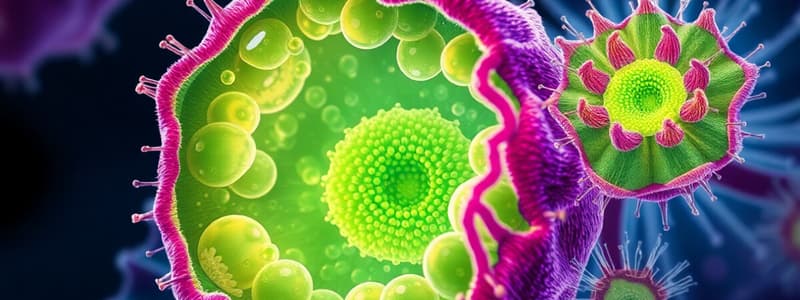Podcast
Questions and Answers
A botanist discovers a new plant species in a rainforest. Initial analysis reveals that the plant's stems are exceptionally flexible, allowing it to bend significantly in strong winds without breaking. Which type of plant cell is most likely predominant in the stems of this plant?
A botanist discovers a new plant species in a rainforest. Initial analysis reveals that the plant's stems are exceptionally flexible, allowing it to bend significantly in strong winds without breaking. Which type of plant cell is most likely predominant in the stems of this plant?
- Sclerenchyma, offering rigid support to prevent over-bending.
- Parenchyma, due to its versatile functions in storage and repair.
- A mix of parenchyma and sclerenchyma to balance flexibility and strength.
- Collenchyma, providing flexible support to withstand bending forces. (correct)
A researcher is studying a plant species that thrives in arid environments. They observe that the plant has specialized cells in its leaves that store large quantities of water. Which type of plant cell is most likely responsible for this water storage?
A researcher is studying a plant species that thrives in arid environments. They observe that the plant has specialized cells in its leaves that store large quantities of water. Which type of plant cell is most likely responsible for this water storage?
- Sclerenchyma, due to its rigid structure that prevents cell collapse under drought conditions.
- A combination of collenchyma and sclerenchyma, providing both flexibility and water retention.
- Collenchyma, because of its ability to expand and contract with changing water availability.
- Parenchyma, given its role in storage and other metabolic functions. (correct)
In a forest ecosystem, a tree is damaged by a storm, resulting in a broken branch. Over time, new cells develop to seal the wound and initiate the development of new tissue. Which type of plant cell is primarily involved in this repair process?
In a forest ecosystem, a tree is damaged by a storm, resulting in a broken branch. Over time, new cells develop to seal the wound and initiate the development of new tissue. Which type of plant cell is primarily involved in this repair process?
- Parenchyma, facilitating tissue repair and replacement. (correct)
- A combination of collenchyma and sclerenchyma for comprehensive repair.
- Collenchyma, providing structural support during the healing process.
- Sclerenchyma, forming a protective barrier against pathogens.
A plant physiologist is investigating the transport of nutrients and water within a newly discovered plant species. Microscopic analysis reveals a significant presence of elongated cells with thick, rigid cell walls in the plant's vascular system. Which type of plant cell is most likely involved in this transport?
A plant physiologist is investigating the transport of nutrients and water within a newly discovered plant species. Microscopic analysis reveals a significant presence of elongated cells with thick, rigid cell walls in the plant's vascular system. Which type of plant cell is most likely involved in this transport?
Farmers notice that a particular crop plant exhibits stunted growth and reduced photosynthetic activity. Microscopic examination of leaf tissue reveals a deficiency in cells responsible for gas exchange. Which type of plant cell is most likely deficient in this crop?
Farmers notice that a particular crop plant exhibits stunted growth and reduced photosynthetic activity. Microscopic examination of leaf tissue reveals a deficiency in cells responsible for gas exchange. Which type of plant cell is most likely deficient in this crop?
Flashcards
Parenchyma cells
Parenchyma cells
Plant cells responsible for storage, photosynthesis, gas exchange, protection and tissue repair.
Collenchyma cells
Collenchyma cells
Plant cells providing support and flexibility to surrounding tissues, and involved in tissue repair.
Sclerenchyma cells
Sclerenchyma cells
Plant cells offering support and aiding in material transport; known for their rigid structure.
Parenchyma tissue function
Parenchyma tissue function
Signup and view all the flashcards
Collenchyma tissue function
Collenchyma tissue function
Signup and view all the flashcards
Study Notes
- Three types of plant cells that comprise the majority of plant tissues include:
Parenchyma
- Functions include storage, photosynthesis, gas exchange, protection, and tissue repair/replacement.
Collenchyma
- Functions include support for surrounding tissues, flexibility for the plant, and tissue repair/replacement.
Sclerenchyma
- Responsible for support and transport.
Studying That Suits You
Use AI to generate personalized quizzes and flashcards to suit your learning preferences.
Related Documents
Description
Learn about the three primary plant cell types: parenchyma, collenchyma, and sclerenchyma. This covers their unique functions in storage, photosynthesis, support, and transport. It also highlights their roles in tissue repair and replacement within plants.



